Couples Yoga Builds Trust And 'Paves The Road To Sexual Intimacy,' This Yoga Instructor Says
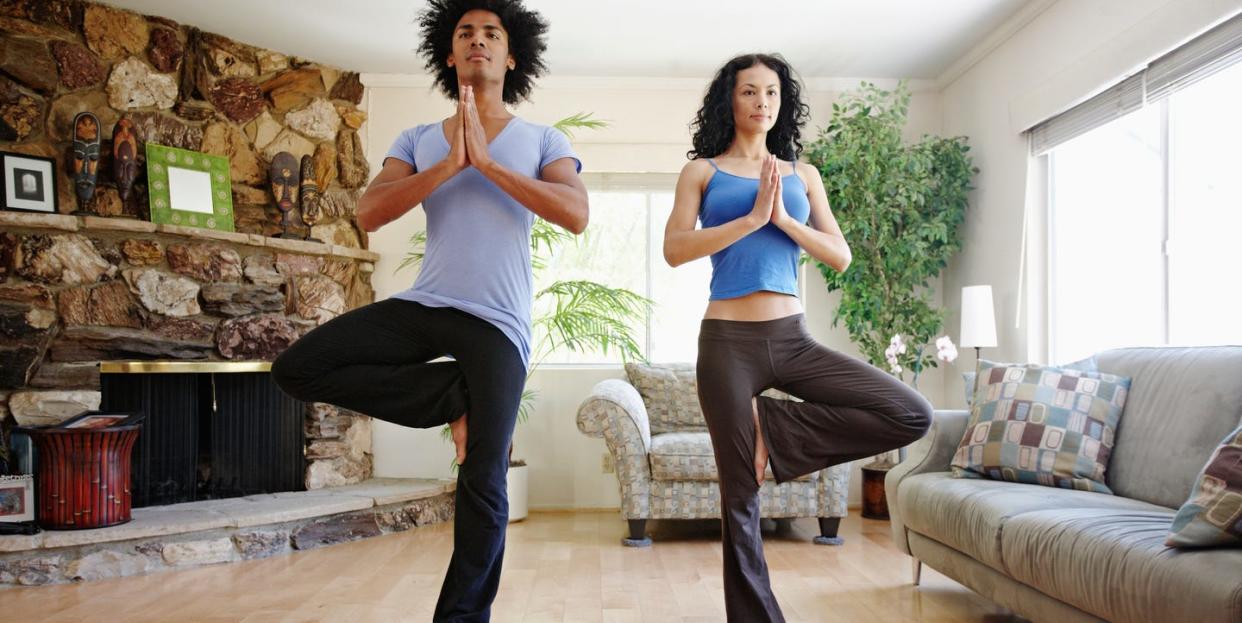
"Hearst Magazines and Yahoo may earn commission or revenue on some items through the links below."
Dinner and a movie. Netflix and chill. A walk through the park and a hot cup of coffee. These are all great date options. But here’s one you might not have considered yet: staying in with your partner to try out some of the best couples yoga poses.
Why is couples yoga so special, you ask? “Unless both partners are equally serious practitioners of yoga, there’s going to be a bit of an imbalance in the partnership that’s going to skew it toward fun,” says Megan Hochheimer, a registered yoga teacher and owner of Karma Yoga & Fitness. You don’t even need to have a specific goal in mind, she adds. You can simply enjoy moving in new ways with someone you love.
What’s more: Couples yoga isn’t *just* a fun activity. It can also be a bonding experience, according to Jane Greer, PhD, a New York-based marriage and family therapist and author of What About Me? Stop Selfishness From Ruining Your Relationship. “You plan the activity, you do it together, you’re both working your bodies, stretching your bodies, learning how to control and relax your bodies—all of which sets you up for future intimacy together,” she explains. “It’s a wonderful activity that paves the road to sexual intimacy.”
Participating in a couples yoga practice provides you and your partner with a shared experience to look forward to and chat about, allowing you to connect before, during, and after your poses, Greer adds.
Even seemingly simple poses will require you and your partner to communicate, which helps build intimacy and trust, she explains. For instance, you might ask your SO where their “edge” is (that point in a stretch where you’re actively participating but it isn’t painful). Plus, you’re empowered to say what you need from your partner.
Since the practice can allow you to take on roles that you might not embody culturally in your day-to-day life, couples yoga may also uncover imbalances to work on in your relationship, according to Hochheimer. For instance, you may discover that your strong, supportive partner is vulnerable when it comes to receiving your support, she explains. From there, you can work on shifting that dynamic in your yoga practice—and it might just translate into the rest of your relationship. “I think it can really be an interesting exercise in reminding your partner, ‘Hey, I can be soft,’ [or] ‘hey, I can be strong, too,’ ” Hochhemier says.
On top of all that, couples yoga can provide a great workout. “When working with a partner, you’ll often be asked to lift your own body weight and a portion of theirs,” Hochheimer explains, “which helps build strength in the skeletal muscles.” Plus, your partner can help you stretch more effectively by offering you resistance or support. With practice, that can lead to a more flexible you, Hochheimer says.
Ready to grab your partner and hit the mat? If so, read on for Hochheimer’s recommended couples yoga poses.
Best Couples Yoga Poses For Beginners
Grab your S.O. and follow these step-by-step instructions to stretch, sweat, and bond with each other. (And remember: Both you and your partner should talk to your docs before diving into a new type of exercise.)
1. Butterfly And Breathe
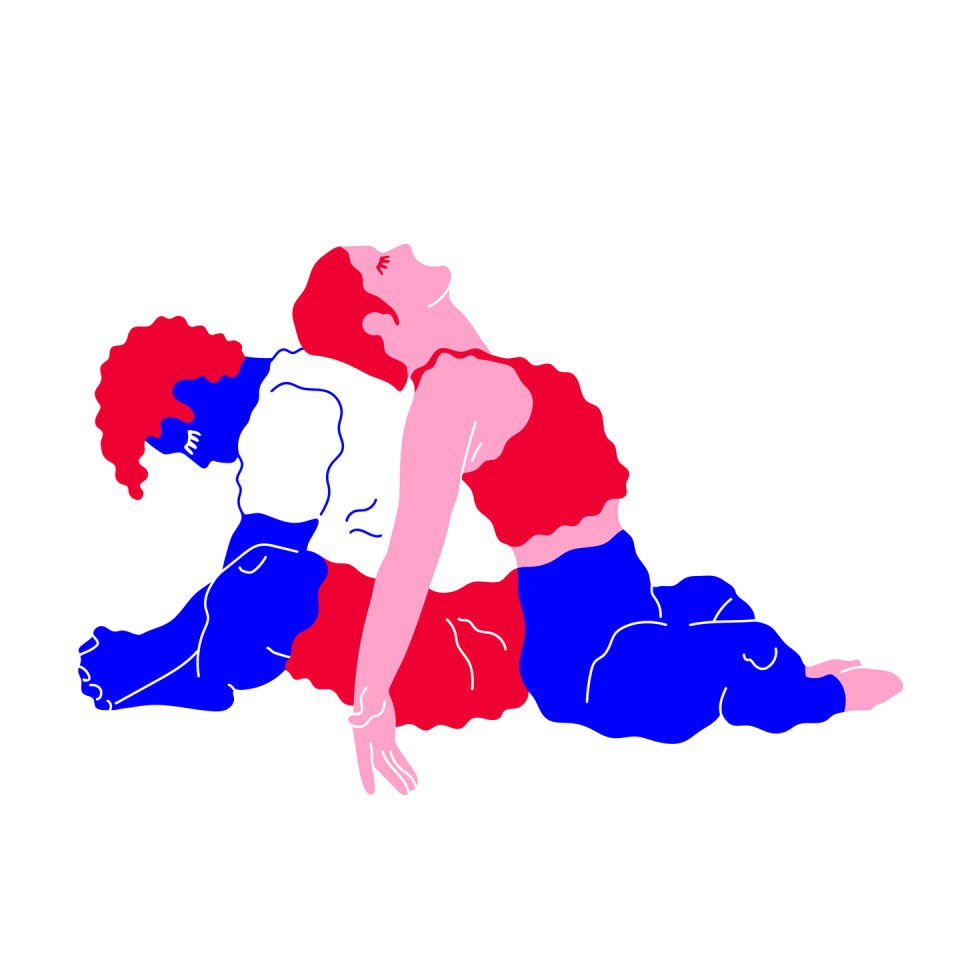
Sit on a yoga mat with your partner, facing opposite directions.
Both partners shift into butterfly sitting position with the bottoms of feet together. Your partner should do the same. (Note: You can incorporate props, like a yoga blanket or towel under your hips or yoga blocks under your knees, for comfort.)
Scoot together so your back is touching your partner’s and you can feel the other’s rhythm of breath.
Close your eyes for a moment and match your partner's breathing.
Fold forward over your legs as your partner leans back.
Hold this position for three to five breaths, then come back up. Switch so that your partner is folding forward and you are leaning back. (The partner who is leaning back can also use a rolled towel under their head or neck if desired.)
2. Double Chair Hold
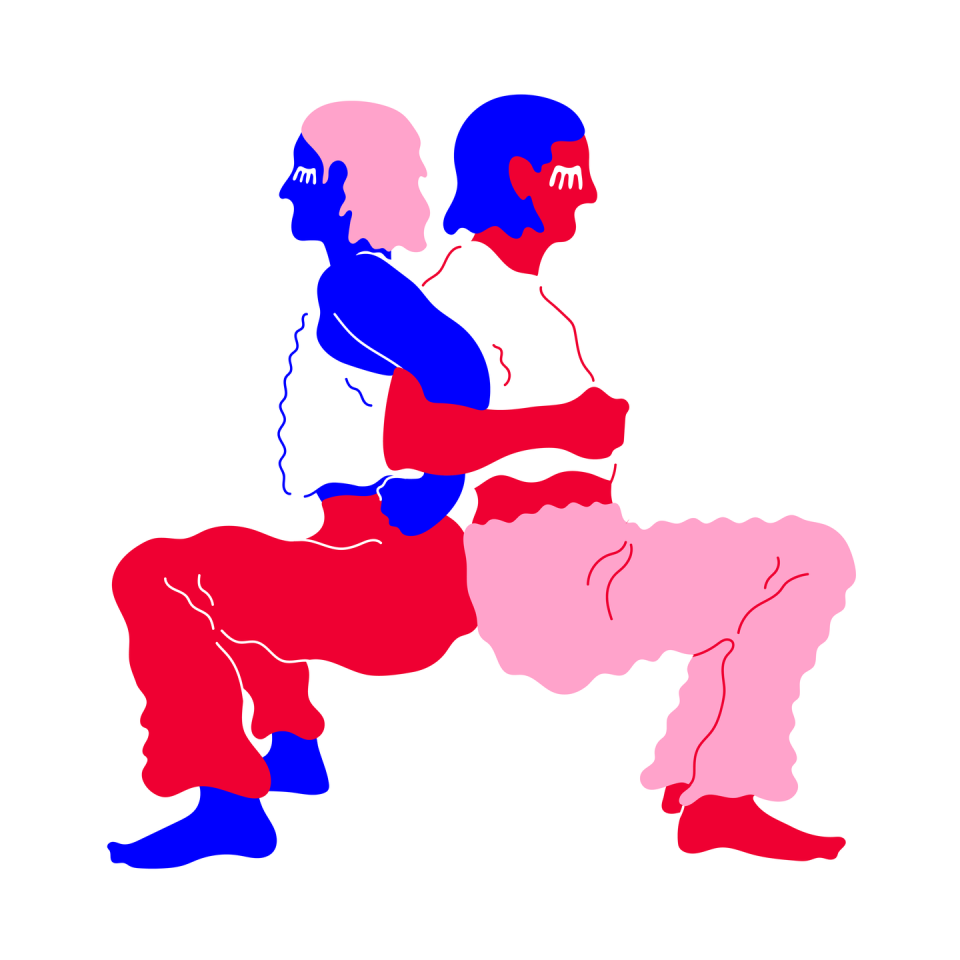
Sit or stand on a yoga mat with your partner, facing opposite directions with feet in a wide, supportive stance. (Begin by standing if you’re just starting out or aren’t sure of your strength, as the seated option is more advanced.)
Link arms and press your backs together.
If you’re standing, slide down into the squat position.
If you’re sitting, brace your core, and press into each other’s backs to rise into a squat position. Communication is key here—and it’s okay to laugh as you master this one!
Hold the pose for three to five breaths, checking that your feet are placed so you are comfortable. (A good rule of thumb is to make sure you can catch a glimpse of your toes out in front of your knees.)
Exit by inhaling to stand all the way up or exhaling to sit all the way down.
3. A Boat For Two
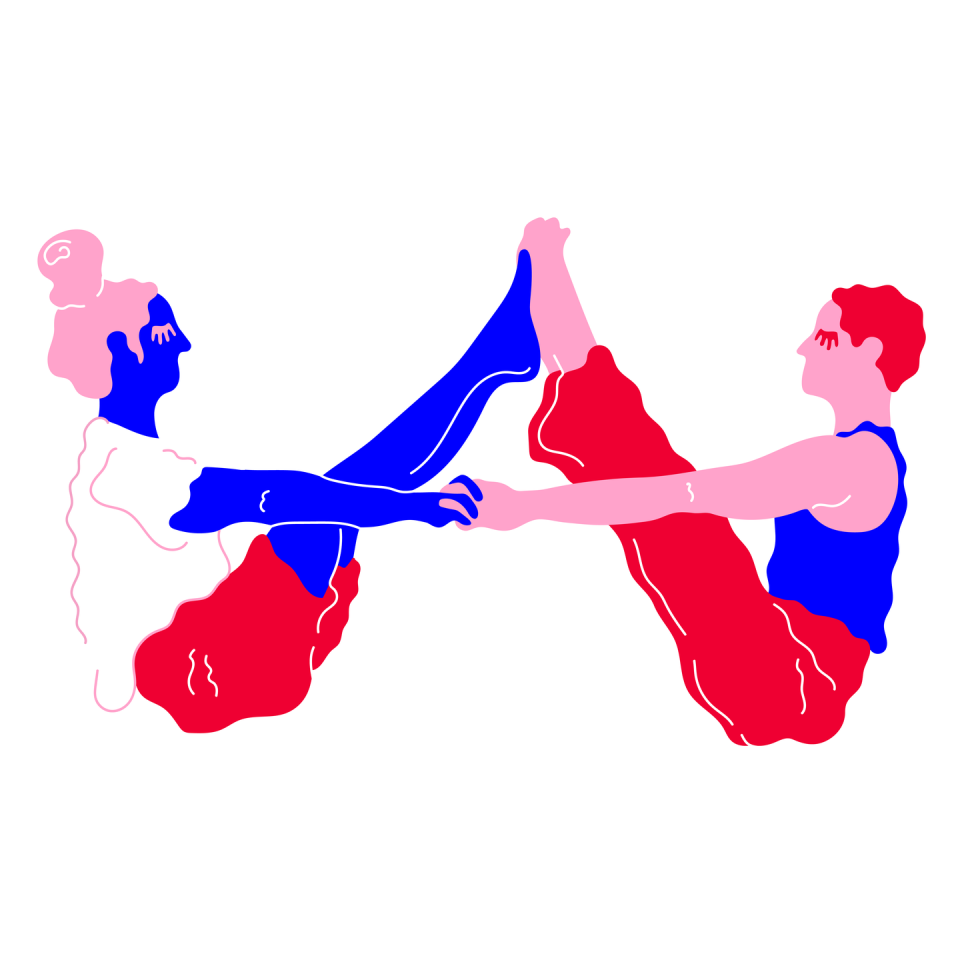
Sit on a yoga mat with your partner, facing each other.
Both partners place the bottoms of your feet on the floor in the middle of the mat, keeping your knees bent.
Move close enough to each other so you can hold hands with your arms outside your legs.
Put the bottoms of your feet together with your partner’s and make eye contact.
On an inhale, both of you lean back just enough to put tension in the hands. Exhale to lift your legs into boat pose. (You can keep your knees bent or straight.) Check in with each other: Make sure both of you feel your core working hard and resting on your sit bones—if not, make small adjustments until you do.
Hold for five breaths, then release. Repeat twice more.
4. Peekaboo Forward Fold
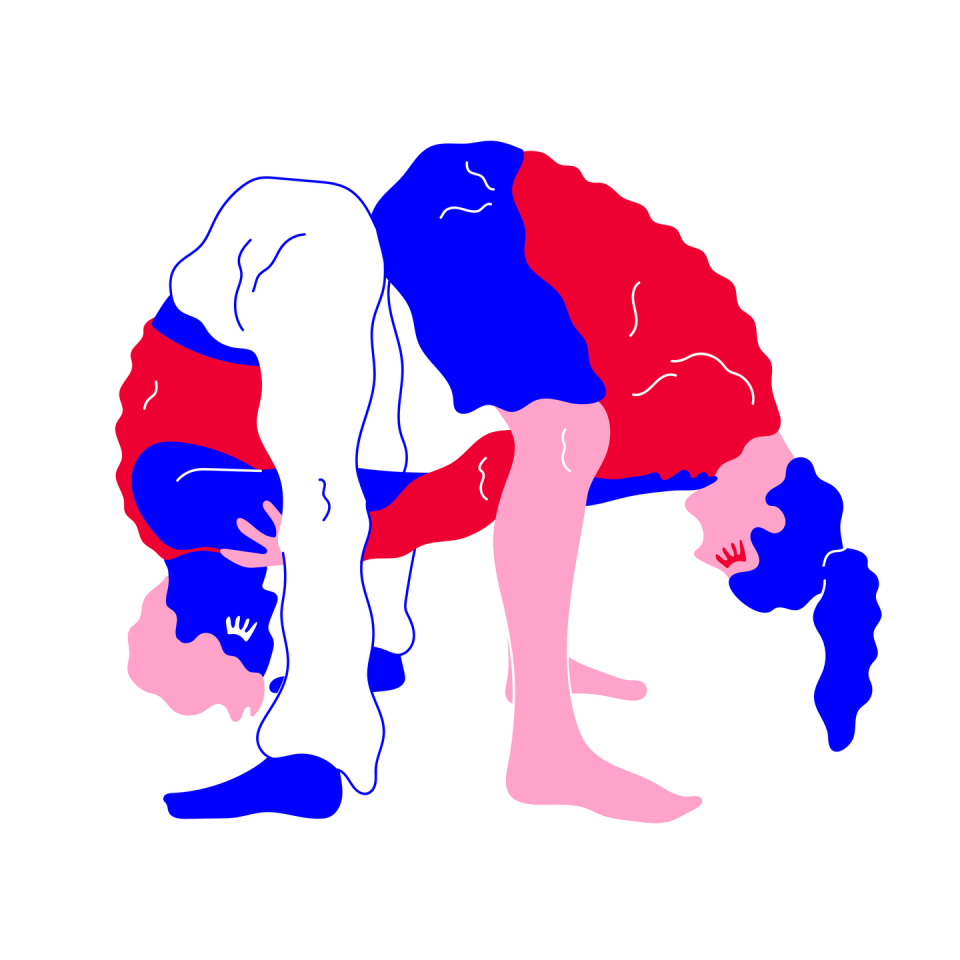
Place two yoga mats together so the long edges are touching.
Stand back-to-back with your partner without touching each other, facing away from where the mats come together.
Both partners step your feet out wide and open your arms to create a five-point star shape. Check that you’re far enough away from your partner so you can both fold forward without tipping each other over.
Both of you exhale and place your hands in front of you on the mat, pressing your feet apart so your legs feel active in the pose. (You might need to move your heels back toward each other at this point.)
When you and your partner are ready, both of you can reach through your legs and either grab hands or link arms.
Keep communicating with one another to ensure you both feel safe. This pose is all about building trust in that forward fold position.
Hold for five full rounds of breath, or practice the pose twice for three rounds of breath. (This pose can definitely be a bit of a head rush!)
5. Twisting Together
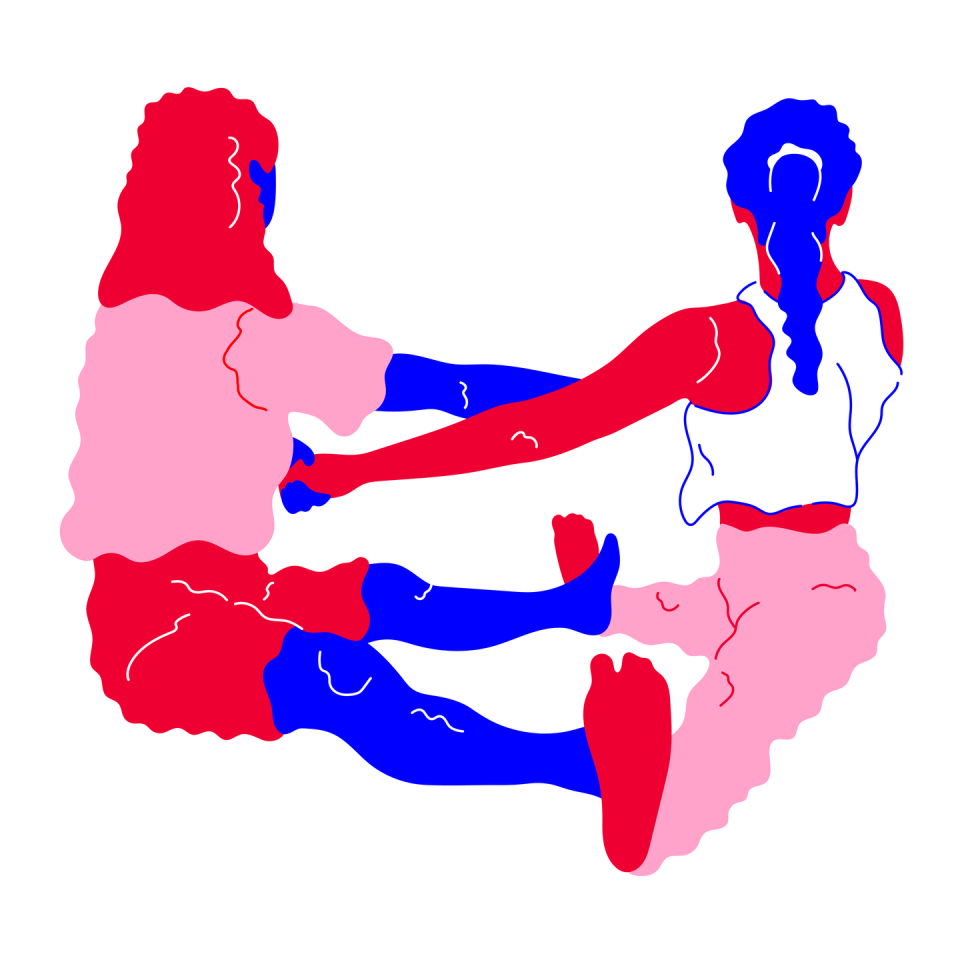
Place two yoga mats together so the long edges are touching.
Sit facing your partner and the line where the mats come together.
Both of you stretch your legs into a straddle. (Whoever’s more flexible can place their feet on the outside of their partner’s feet.)
Clasp opposite hands, and make eye contact with your partner. Then, decide which direction to twist in first. (You should both end up facing the same direction, so if you twist to the right, your partner will twist left.)
Flow back and forth in a gentle, washing machine-like motion, or hold the twist for five breaths on each side.
To exit the pose, release each other’s hands and fold your feet into a butterfly pose.
6. Down Dog With Help
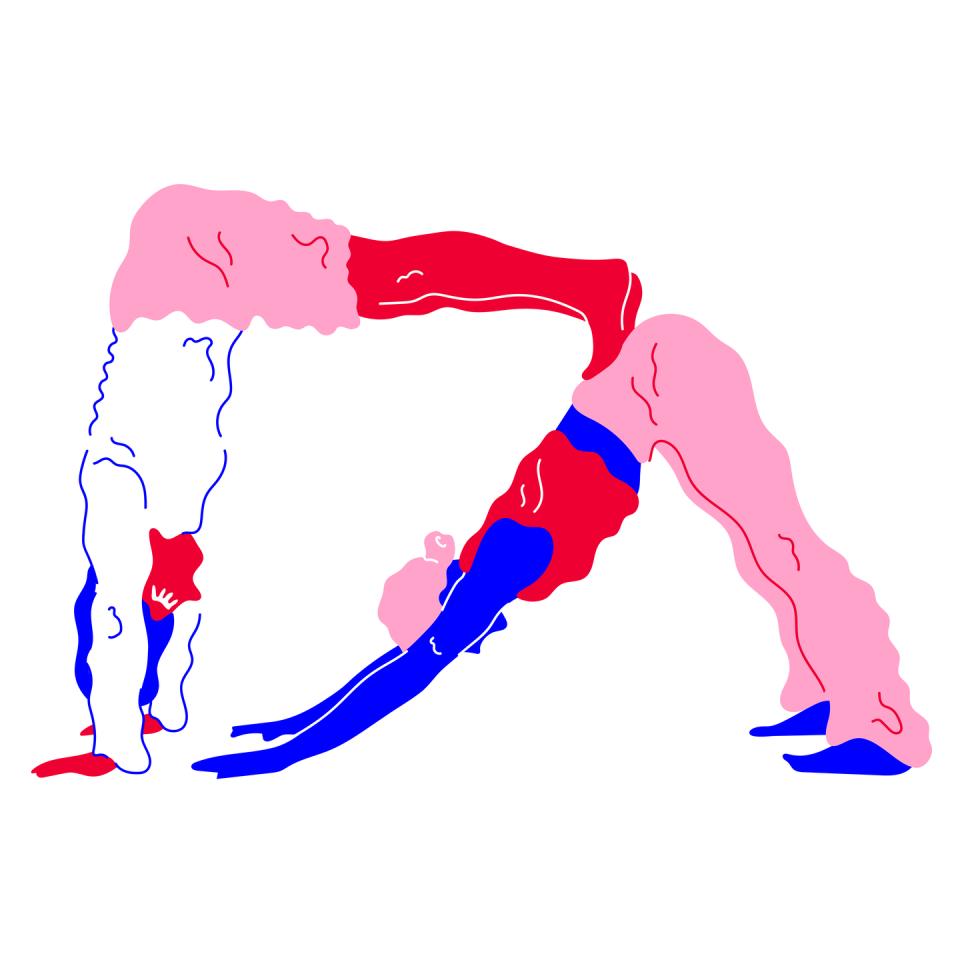
Note: For this pose, you’ll want to settle on who will be Partner 1 and who will be Partner 2 before beginning. You’ll have the chance to switch roles for round two.
Place two yoga mats end-to-end. On an exhale, Partner 1 slides their hands forward, lifts their knees, and raises their hips up and back into downward facing dog. Partner 2 begins standing in mountain pose slightly in front of Partner 1’s hands, facing away from them.
Once Partner 1 is comfortable in the downward dog pose, Partner 2 places their hands on the mat a bit wider than Partner 1’s hands. (How far away from Partner 1 they place their hands will depend on the height difference between the two partners.)
Partner 2 shifts weight to their hands and places one foot on the back of Partner 1’s pelvis. Keep in mind that the lower back can be tender.
Partner 2 places their second foot on the back of Partner 1’s pelvis. They can either keep their knees bent at this point or start to straighten.
Determine how long you’ll stay in the pose based on Partner 2’s upper body endurance. Start with five breaths as a goal.
When the pose ends, Partner 2 can exit by climbing or jumping down. Alternatively, Partner 1 can return to tabletop position to ease the transition. Communicate about your plan.
Switch roles and repeat.
7. Picture Frame Pose
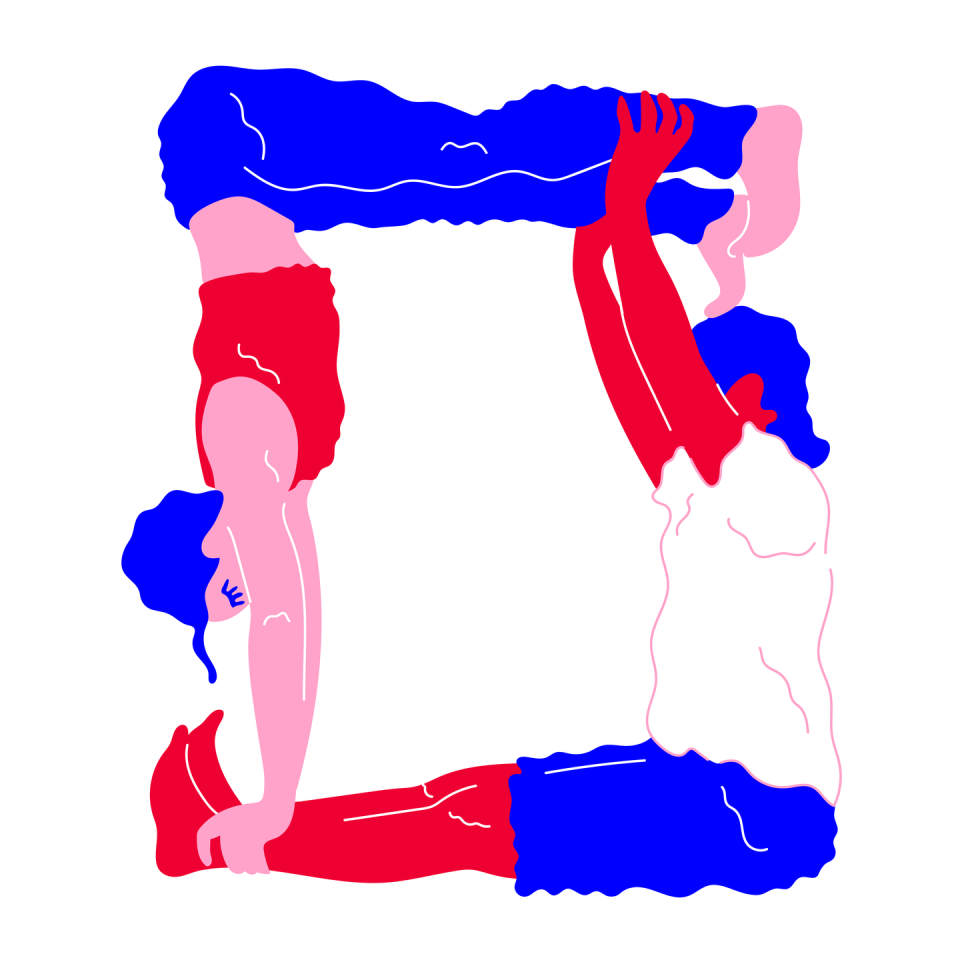
Note: For this pose, you’ll want to settle on who will be Partner 1 and who will be Partner 2 before beginning. You’ll have the chance to switch roles for round two.
Partner 1 starts sitting on the mat with their legs extended in front of them. (They can sit against a wall if their core feels weak or if their hamstrings are tight.)
Partner 2 stands facing away from Partner 1, close to their feet. Then, place their hands on the floor outside Partner 1’s ankles or feet (depending on what feels best for your height difference) and step feet (one at a time) onto Partner 1’s shoulders.
Stay in this position, or have Partner 1 hold Partner 2’s ankles and lift them up on the next collective inhale. Your bodies should form a rectangle shape. Partner 2 can also walk their hands onto Partner 1’s ankles for an extra challenge.
Communicate with one another to determine how long you’re able to hold the pose and as you’re on the way out. If it feels difficult for the wrists or hamstrings, have Partner 2 come down after a few breaths.
8. Child's Pose Massage
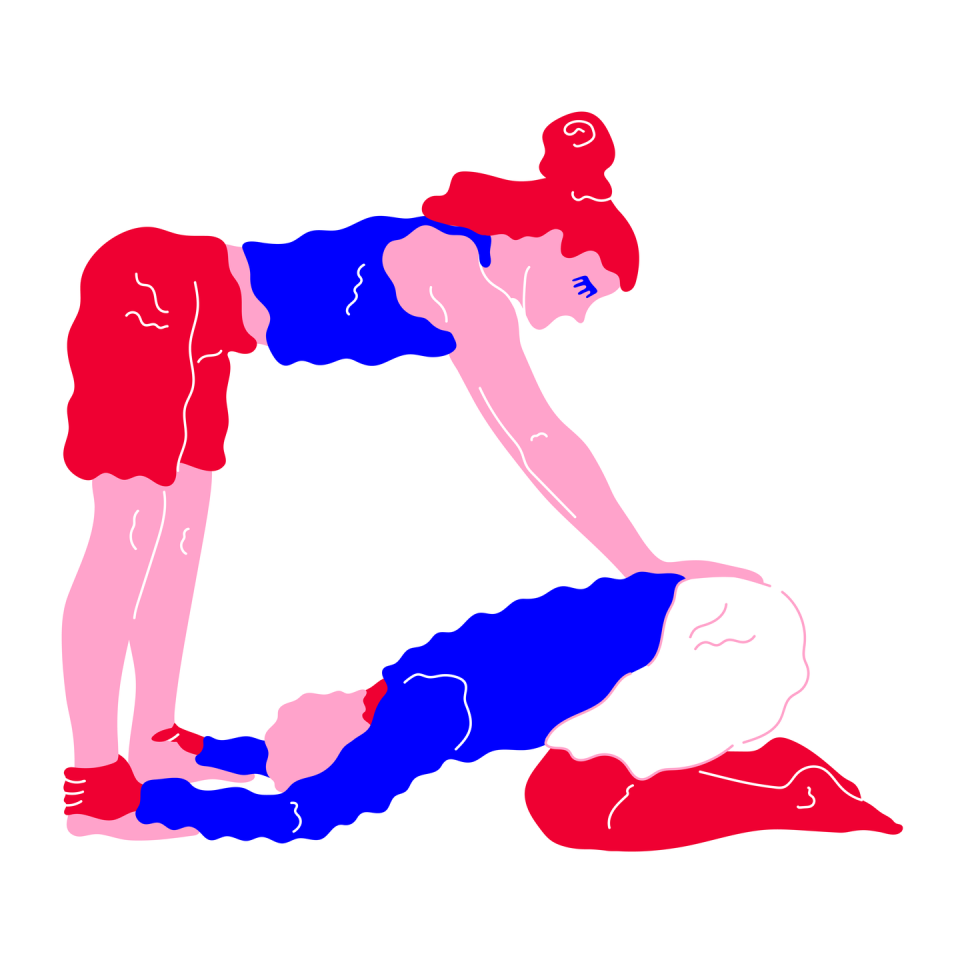
Note: For this pose, you’ll want to settle on who will be Partner 1 and who will be Partner 2 before beginning. You’ll have the chance to switch roles for round two.
Partner 1 starts kneeling on the mat facing Partner 2, standing on the back half of the mat.
Partner 1 lowers hips to heels, and forehead to the floor, settling into child's pose.
Then, Partner 1 holds Partner 2’s ankles with a neutral grip (palms facing in toward the midline of the body).
Partner 2 folds forward, engaging core, and places their hands gently on Partner 1’s back. Partner 2 keeps knees bent and a strong posture to protect their lower back as they massage Partner 1's back.
For five breaths or more, get creative with the massage component of this pose—talk about what feels good!
On an inhale, both partners slowly rise to exit the pose. Switch roles and repeat.
Best Advanced Couples Yoga Poses
9. Kneeling Handstand Helper
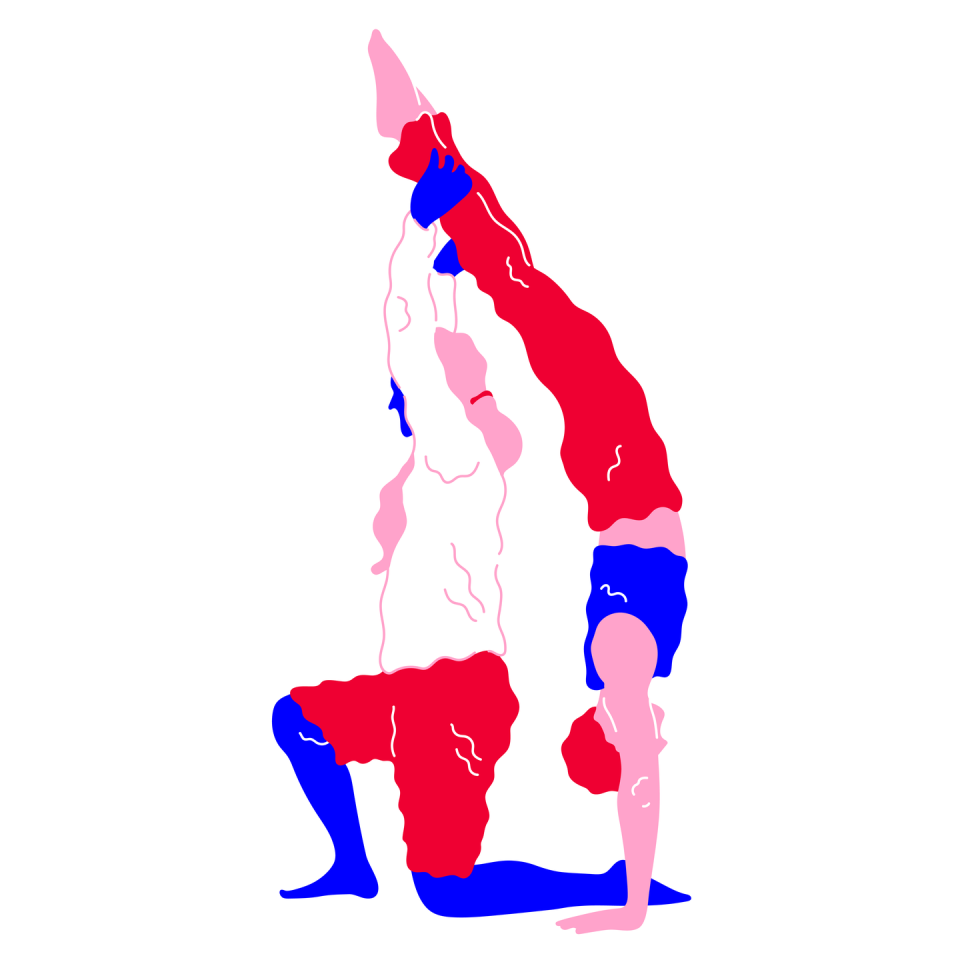
Note: For this pose, you’ll want to settle on who will be Partner 1 and who will be Partner 2 before beginning, as well as discuss the entry into and exit from the pose. You’ll have the chance to switch roles for round two.
Partner 1 starts in a low lunge on the mat. (Use a blanket under the knees for extra support.) Partner 2 stands behind Partner 1, facing their back.
Keeping legs engaged, Partner 1 raises arms in the air.
Partner 2 places hands on the mat on either side of Partner 1’s back leg. Then, Partner 2 shifts their weight forward and lifts one leg in the air.
Partner 1 catches the leg and supports them into a handstand kick-up. Communication is crucial here, since you can’t make eye contact with one another.
Hold the pose for two breaths, then Partner 2 comes down one leg at a time.
Have Partner 1 switch which leg is in front, then repeat.
After a break, switch roles and repeat if you’d like.
10. Down Dog Backpack
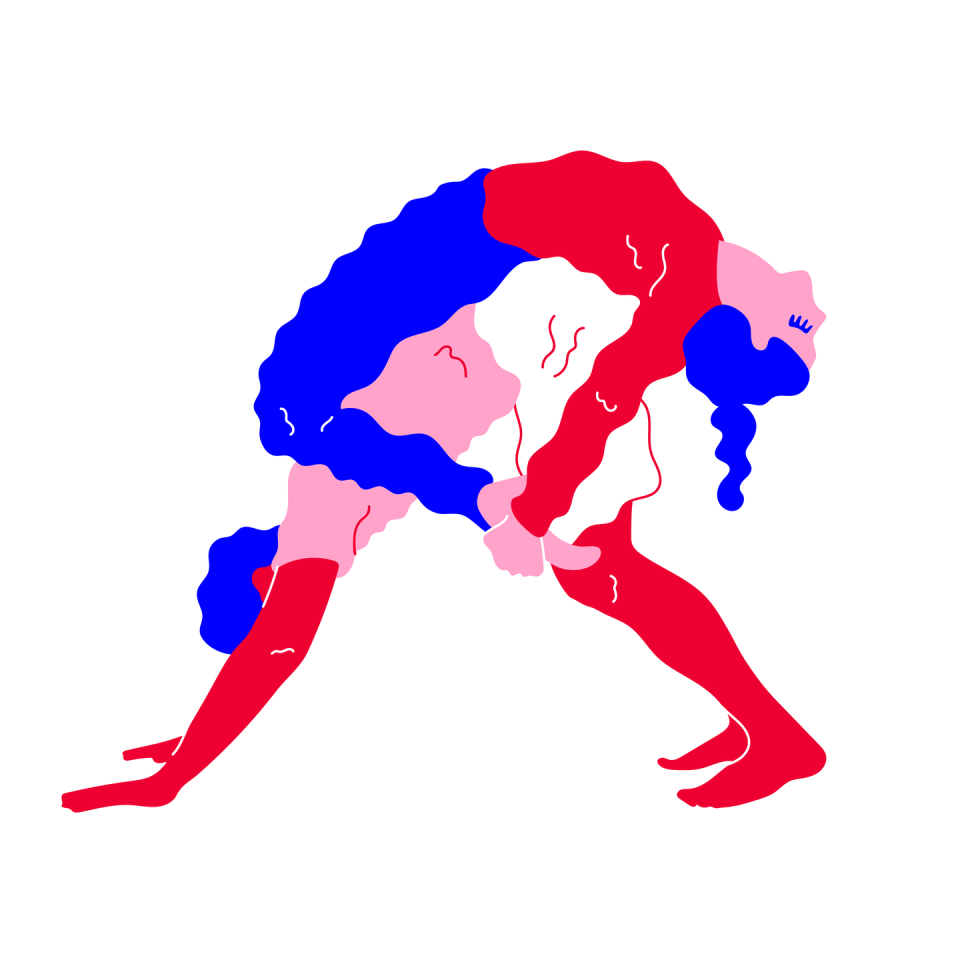
Note: For this pose, you’ll want to settle on who will be Partner 1 and who will be Partner 2 before beginning. Keep in mind that the decision will be unique to each partnership, and height and weight differences might make switching the positions for this pose dangerous or not as much fun.
Partner 1 starts in a high plank in the center of the mat.
On an exhale, Partner 1 presses their hips up and back into downward facing dog. (If hamstrings are tight, hey can keep knees bent or put a blanket under heels.)
Partner 2 stands facing away from Partner 1 near their hands. Once Partner 1 is in a comfortable downward dog position, lower knees toward the floor and activate core so Partner 2 can lie over their back.
Partner 2 positions their legs over Partner 1’s shoulders and their head near Partner 1’s hips. Communicate through the movement to ensure you're both comfortable.
Partner 1 pushes hips up to resume full downward facing dog with Partner 2 on their back.
For added challenge, Partner 2 can do a backbend across Partner 1’s lower back. Partner 2 brings legs outside Partner 1’s arms, bends knees, and connects hands and feet in bow pose.
Breathe and communicate with each other and stay in the pose as long as you're both comfortable.
Slowly reverse the movements to exit the pose.
11. Flying Backbend
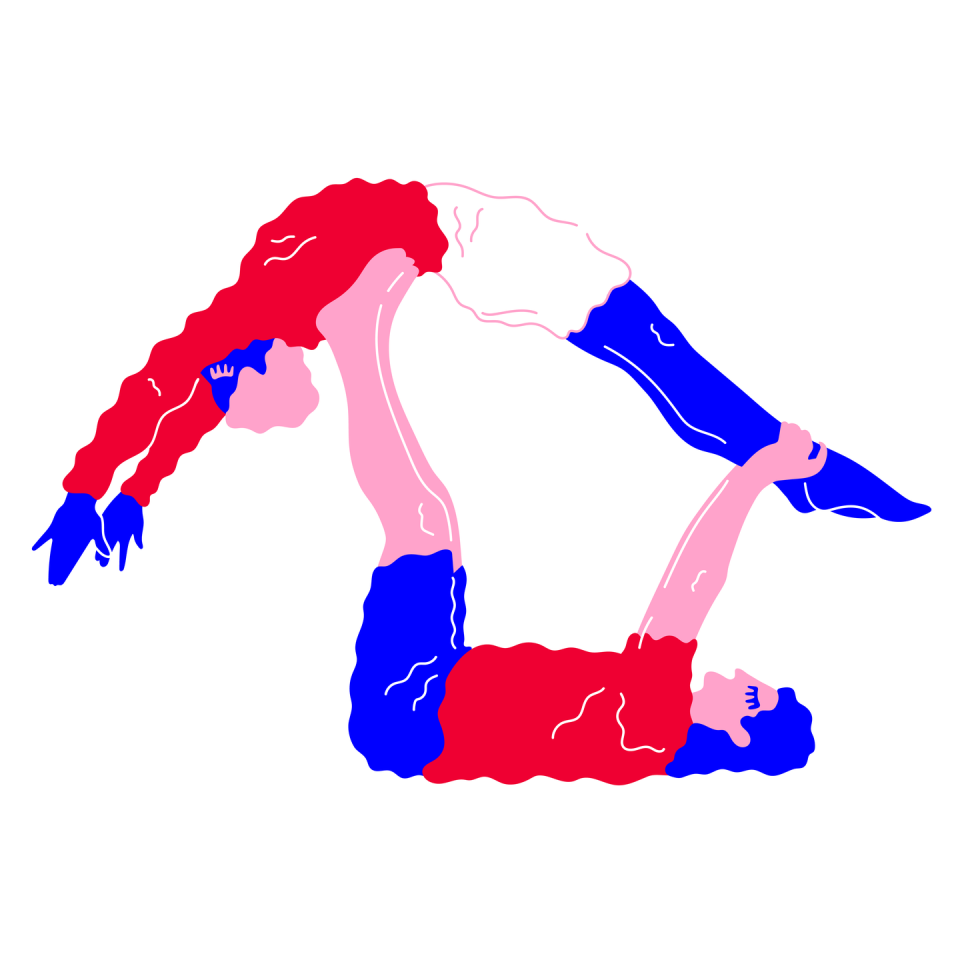
Note: For this pose, you’ll want to settle on who will be Partner 1 and who will be Partner 2 before beginning. Keep in mind that the decision will be unique to each partnership, and height and weight differences might make switching the positions for this pose dangerous or not as much fun.
Partner 1 starts lying face up on the mat or other soft surface. (If the lower back or hamstrings feel tight, place a folded blanket under hips.)
Partner 2 stands facing in the opposite direction near Partner 1’s hands and head. (Note: As the base, Partner 1 directs all movement for this pose, while Partner 2 provides a structured, engaged body. If Partner 2 is limp or too relaxed, the workload may be too heavy for Partner 1.)
Partner 1 bends knees and lifts straight legs in the air to form a 90 degree angle with the ground. Then, wrap hands around Partner 2’s ankles and lift their hips to place their feet on Partner 2’s back. (Partner 2 leans back slightly so Partner 1 can catch.)
In one fluid motion and on an inhale, Partner 1 guides Partner 2 into the air.
Partner 1 lightly pulls on Partner 2’s feet and presses in the opposite direction with their legs to help them find maximal spinal extension in their backbend.
Communicate while holding the position since you can't make eye contact. This is a major trust-builder, so don’t pressure yourself to stay in the pose for a certain length of time.
Rewind the motion to exit the pose.
12. Spider Kisses Arm Balance
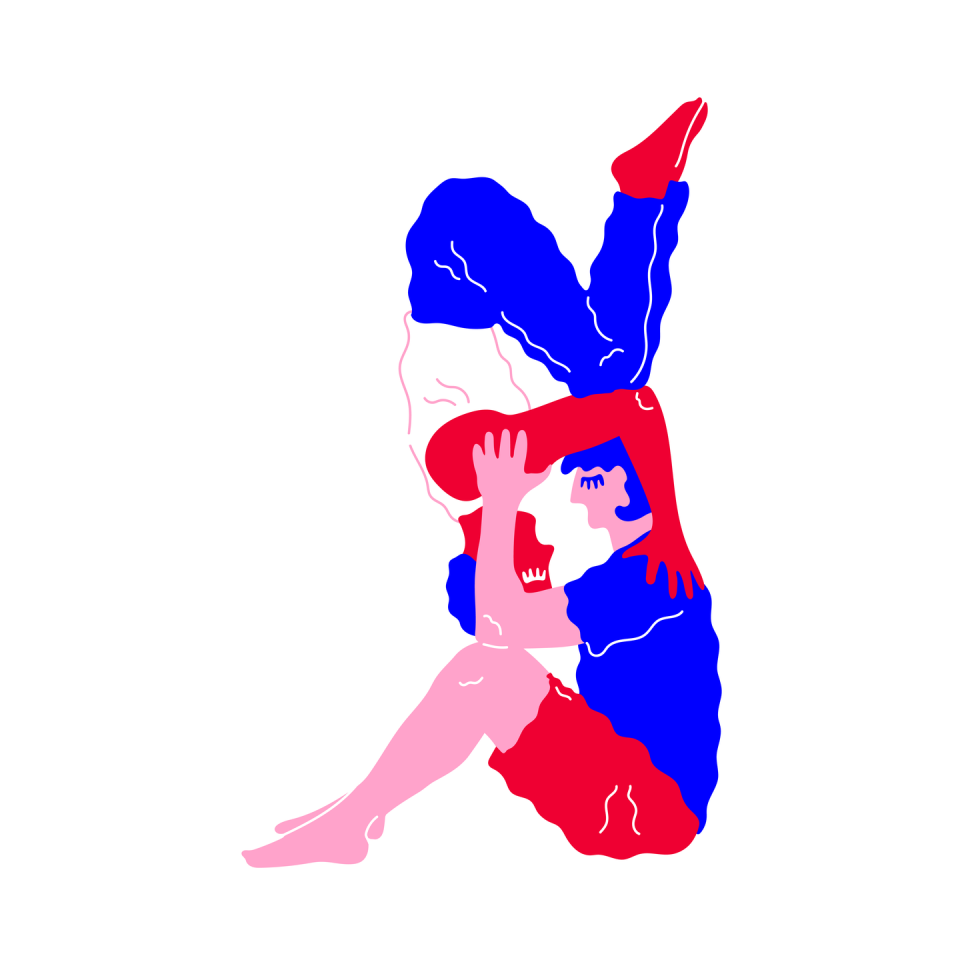
Note: For this pose, you’ll want to settle on who will be Partner 1 and who will be Partner 2 before beginning. Keep in mind that the decision will be unique to each partnership, and height and weight differences might make switching the positions for this pose dangerous or not as much fun.
Partner 1 (the base partner) starts sitting in the center of the yoga mat with knees bent, feet on the floor, and elbows braced against the knees. Maintain engagement in the legs and active core throughout the pose to reduce the pressure on the upper body.
Partner 2 stands behind Partner 1, facing the same direction. Then, Partner 2 places their hands on Partner 1’s shoulders and rises onto their toes. (They can also stand on yoga blocks for extra height.)
Partner 2 lowers their face down in front of their partner (upside down), bringing their shoulders into Partner 1’s hands. Then, Partner 2 engages core and rounds the spine, bringing feet into the air or onto their elbows. (Squeeze the knees and feet together tightly and bend the knees.)
If both partners are comfortable, Partner 2 can play with leg variations—or even sneak an upside down kiss. Discuss how long everything feels safe, strong, and fun in the position.
Rewind these steps to exit the pose, being cautious with the base partner’s head and neck.
You Might Also Like
